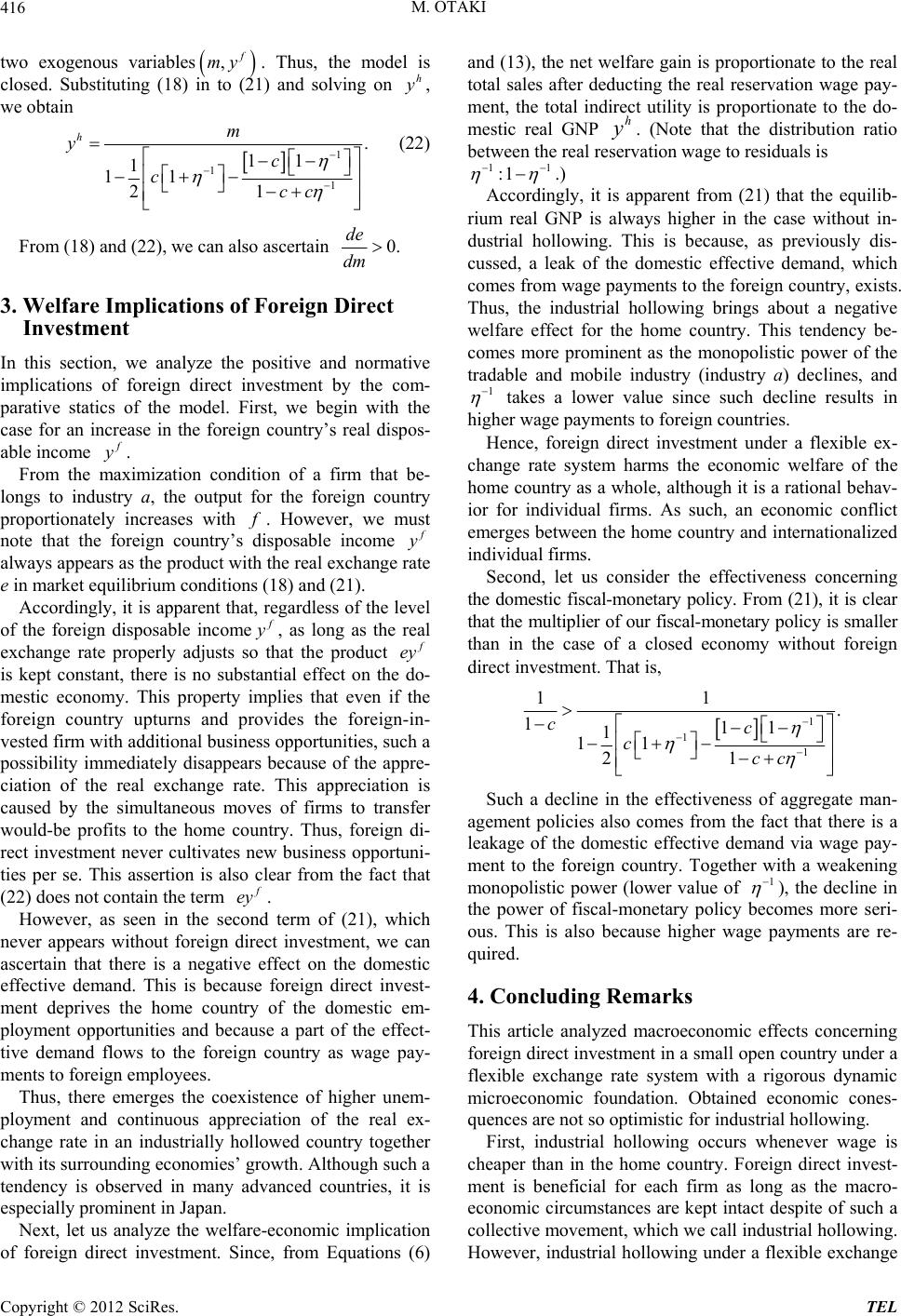
M. OTAKI
416
s
,
my
in to
two exogenous variable. Thus, the model is
closed. Substituting (18) (21) and solving on h
,
we obtain
1
1
m
1
11
21
ccc
From (18) and (22), we can also ascertain
.
11
1
h
yc
( 22)
0.
de
dm
ative
-
with the
pos-
3. Welfare Implicatoreign Dir
Investment
In this section, we analypositive and norm
implications of foreign ent by the com
pa in
case for a dis
able income
ions of F
ze the
direct investm
ect
rative statics of the model. First, we beg
n increase in the foreign country’s real
.
lon he r the foreign co
From the maximization condition of a firm that
gs to industry a, t
be-
untryoutput fo
proportionately increases with
. However, we must
note that the foreign country’s disposable income
always appears as the product with the real exchange rate
e in market equilibrium conditions (18) and (21).
Accordingly, it is apparent that, regardless of the level
of the foreign disposable income
, as long as the real
exchange rate properly adjusts so that the product
ey
is kept constant, there is no substantial effect on the do-
mestic economy. This property implies that even if the
foreign country upturns and provides the foreign-in-
vested firm with additional business opportunities, such a
possibility immediately disappears because of the appre-
ciation of the real exchange rate. This appreciation is
caused by the simultaneous moves of firms to transfer
would-be profits to the home country. Thus, foreign di-
rect investment never cultivates new business opportuni-
ties per se. This assertion is also clear from the fact that
(22) does not contain the term
ey .
However, as seen in the second term of (21), which
never appears without foreign direct investment, we can
ascertain that there is a negative effect on the domestic
effective demand. This is because foreign direct invest-
ment deprives the home country of the domestic em-
ployment opportunities and because a part of the effect-
tive demand flows to the foreicountry as wage pay-
me
gn
nts to foreign employees.
Thus, there emerges the coexistence of higher unem-
ployment and continuous appreciation of the real ex-
change rate in an industrially hollowed country together
with its surrounding economies’ growth. Although such a
tendency is observed in many advanced countries, it is
especially prominent in Japan.
Next, let us analyze the welfare-economic implication
of foreign direct investment. Since, from Equations (6)
and (13), the net welfare gain is proportionate to the real
total sales after deducting the real reservation wage pay-
ment, the total indirect utility is proportionate to the do-
mestic real GNP h
. (Note that the distribution ratio
between the real reservation wage to residuals is
11
:1
.)
Accordingly, it is apparent from (21) that the equilib-
rium real GNP is always higher in the case without in-
dustrial hollowing. This is because, as previously dis-
cussed, a leak of the domestic effective demand, which
comes from wage payments to the foreign country, exists.
Thus, the industriaollowing brings about a negative
welfare effect for the home country. This tendency
l h
be-
comes more prominent as the monopolistic power of the
tradable and mobile industry (industry a) declines, and
1
takes a lower value since such decline results in
higher wage payments to foreign countries.
Hence, foreign direct investment under a flexible ex-
change rate system harms the economic welfare of the
home country as a whole, although it is a rational behav-
ior for individual firms. As such, an economic conflict
emerges between the home country and internationalized
individual firms.
econd, let us consider the effectiveness concerning
the domestic fiscal-monetary policy. From (21
S
), it is clear
that the multiplier of our fiscal-monetary policy is smaller
than in the case of a closed economy without foreign
direct investment. That is,
1
11
.
1c
1
1
11
21
ccc
11
1c
Such a decline in the effectiveness of aggregate man-
agement policies also comes from the fact that there is a
leakage of the domestic eff
ective demand via wage pay-
ment to the foreign country. Together with a weakening
monopolistic power (lower value of 1
beco
), the decline in
the power of fiscal-monetary policymes more seri-
ous. This is also because higher wage payments are re-
quired.
industrial hollowing occurs whenever wage is
try. Foreign direct invest-
m as long as the macro-
However, industrial hollowing under a flexible exchange
4. Concluding Remarks
This article analyzed macroeconomic effects concerning
foreign direct investment in a small open country under a
flexible exchange rate system with a rigorous dynamic
microeconomic foundation. Obtained economic cones-
quences are not so optimistic for industrial hollowing.
First,
cheaper than in the home coun
ment is beneficial for each fir
economic circumstances are kept intact despite of such a
collective movement, which we call industrial hollowing.
Copyright © 2012 SciRes. TEL